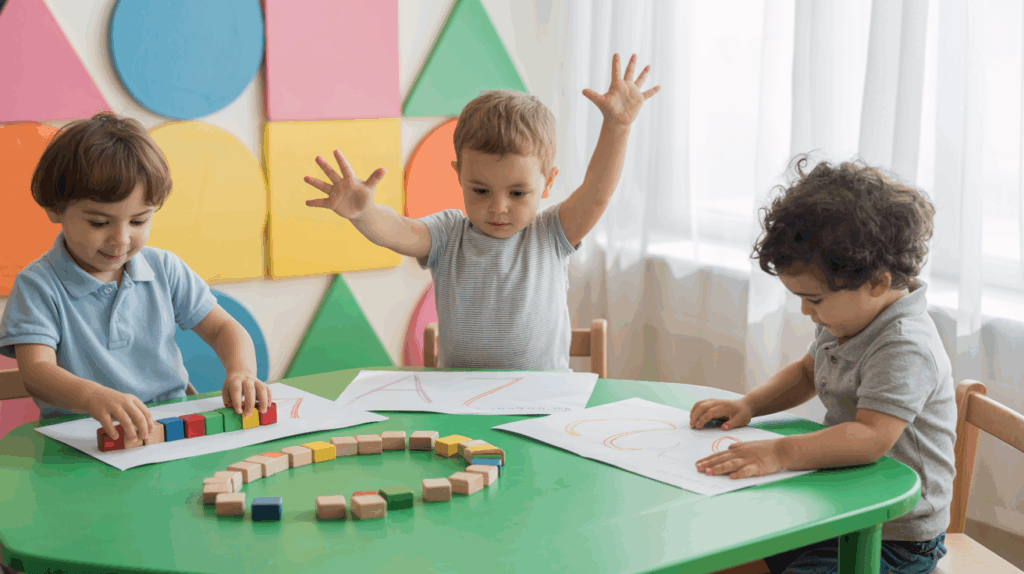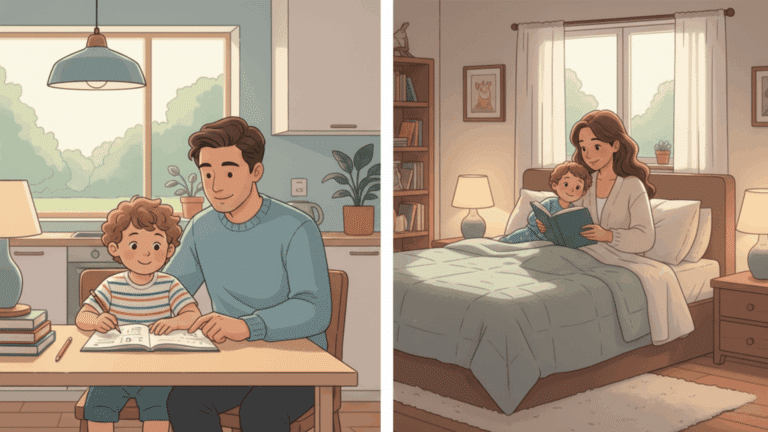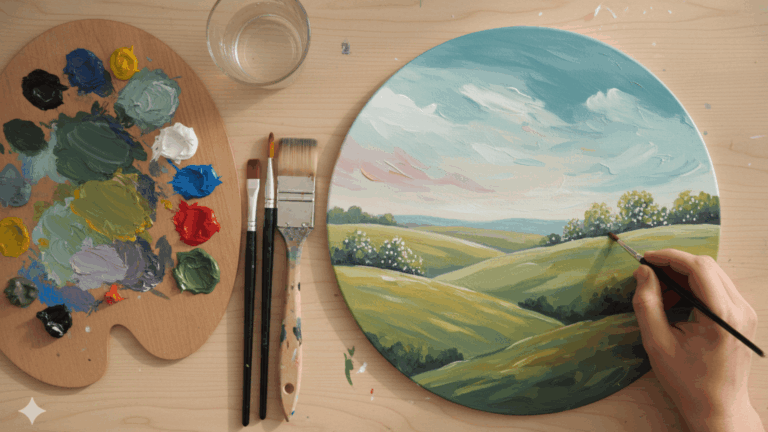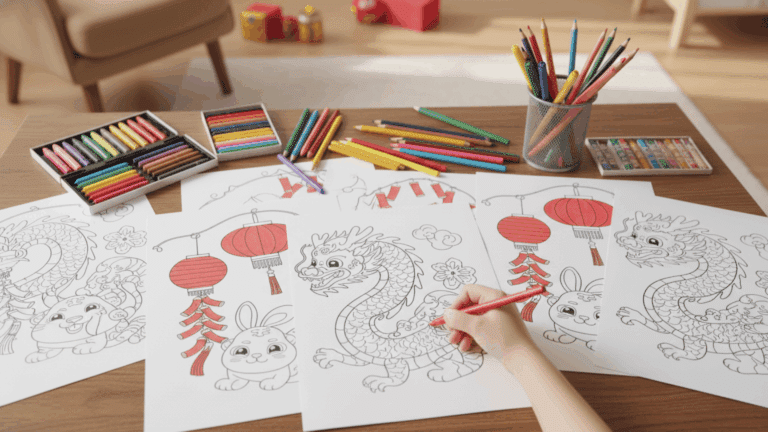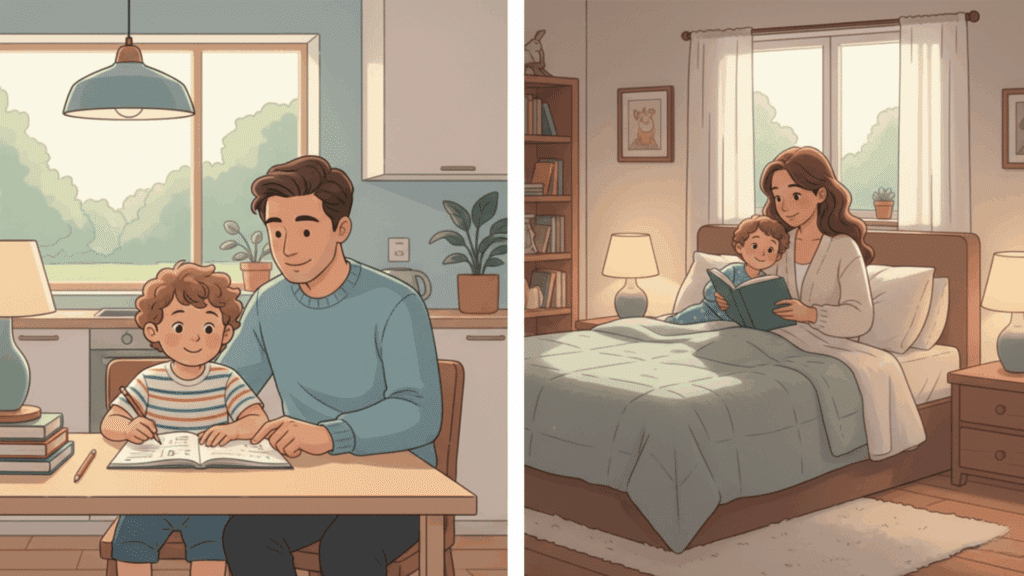Does math make preschoolers run away faster than bath time?
Many parents and teachers face the same challenge. They want to introduce basic math concepts, but little ones lose interest quickly. Traditional counting feels boring, and number worksheets put kids to sleep.
Math activities for preschoolers feel like play when they involve counting their toys, sorting their snacks, and comparing sizes without even knowing they’re doing math.
The secret lies in turning numbers into games that make them giggle and ask for more.
Benefits of Math Activities for Preschoolers
Math activities give preschoolers more than number skills. These fun games build important abilities that help children succeed in school and life.
- Builds Number Understanding: Kids learn what numbers really mean through play. When they count toys or sort blocks, they see that three means three real materials. This makes future math learning much easier.
- Improves Problem-Solving: Math games teach kids to think through problems step by step. They learn to figure out the material on their own. This skill helps them in all areas of life.
- Strengthens Hand Skills: Picking up small counting objects and drawing shapes makes little fingers stronger. Better hand control helps with writing and other school tasks later.
- Builds Confidence: Success in fun math activities makes kids feel smart and capable. They get excited about learning new Material. This positive feeling stays with them as they grow.
- Teaches New Words: Math play introduces words like “big,” “small,” “more,” and “less” naturally. Kids also learn to explain their thinking, which helps them communicate better.
- Prepares for School: Children who know basic math before kindergarten do better in all subjects. They feel confident and ready to learn harder concepts when the time comes.
Exciting Math Activities for Preschoolers to Try
These activities are a fun and interactive way to help children develop early math skills. They encourage counting, shape recognition, and problem-solving through hands-on play and exploration.
1. Number Hunt
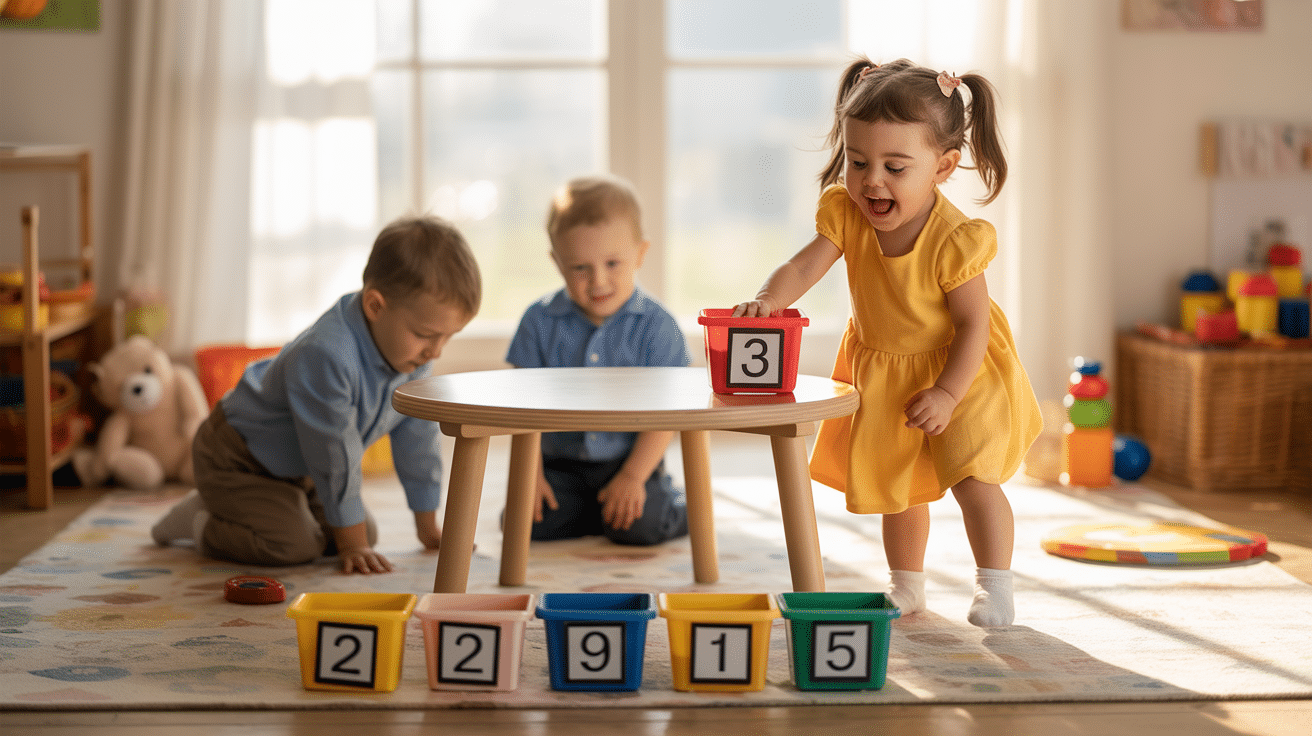
Number Hunt is a fun activity where preschoolers search for numbers hidden around the room or outdoor space. It helps children practice number recognition and counting while engaging in active play.
- Material Required: Number cards, small containers, or objects with numbers.
- Lessons Covered: Number recognition, counting, and fine motor skills.
- Difficulty Level: Easy
2. Shape Sorting
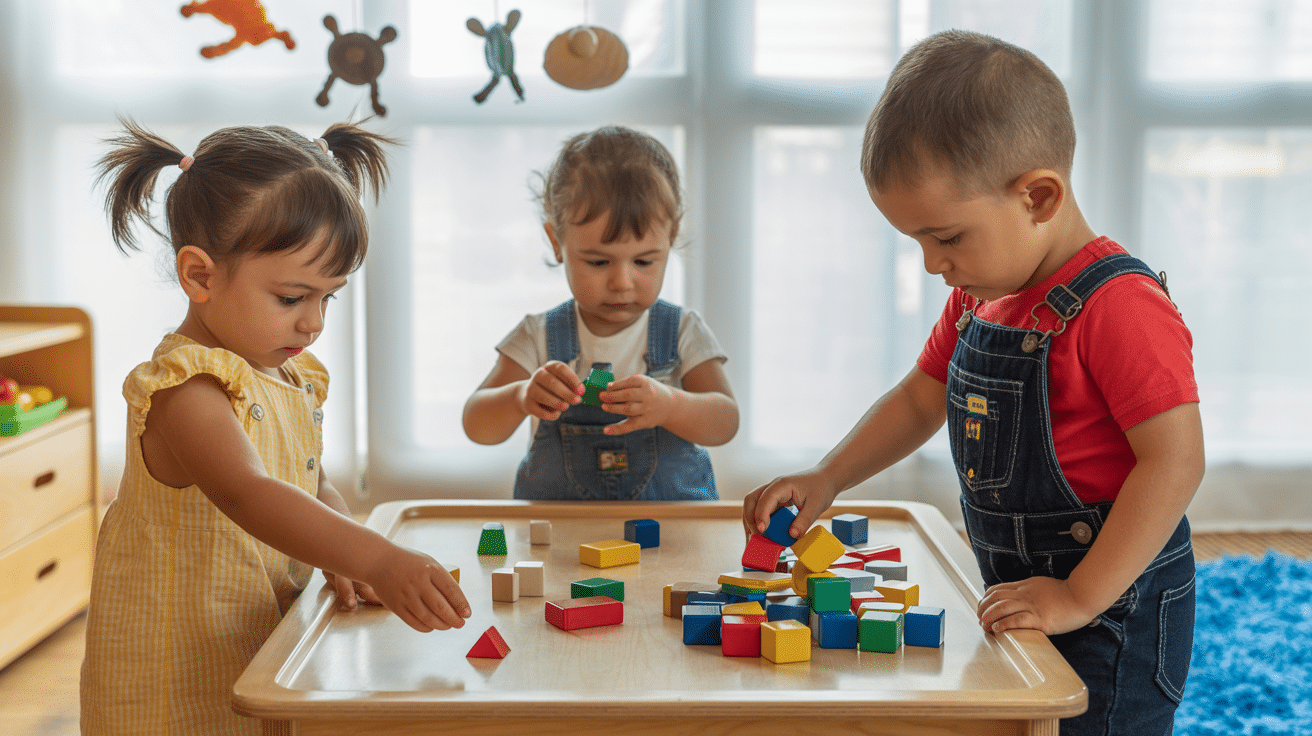
In Shape Sorting, children are given differently shaped objects and asked to sort them into categories based on their shape. This helps enhance shape recognition and sorting skills.
- Material Required: Various shaped objects (blocks, cutouts, or toys).
- Lessons Covered: Shape recognition, sorting, and categorization.
- Difficulty Level: Easy
3. Counting Bears

Counting Bears involves using colorful bear counters to help children practice counting and simple addition or subtraction in a hands-on, engaging way.
- Material Required: Bear counters or similar small toys, number cards.
- Lessons Covered: Counting, basic math operations, color recognition.
- Difficulty Level: Easy
4. Playdough Numbers
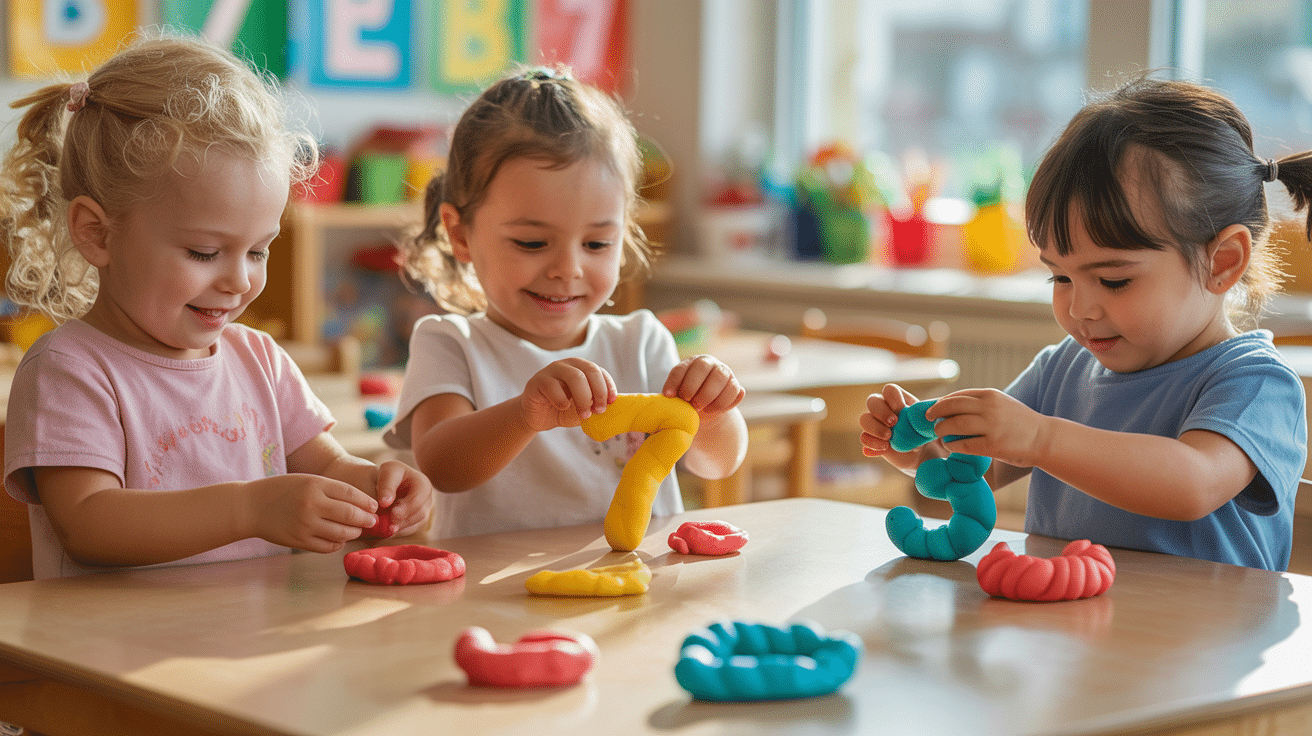
Playdough Numbers encourages children to mold numbers out of playdough, helping them reinforce their number recognition while improving their fine motor skills.
- Material Required: Playdough, number printouts or guides.
- Lessons Covered: Number recognition, fine motor skills, creativity.
- Difficulty Level: Medium
5. Pattern Blocks
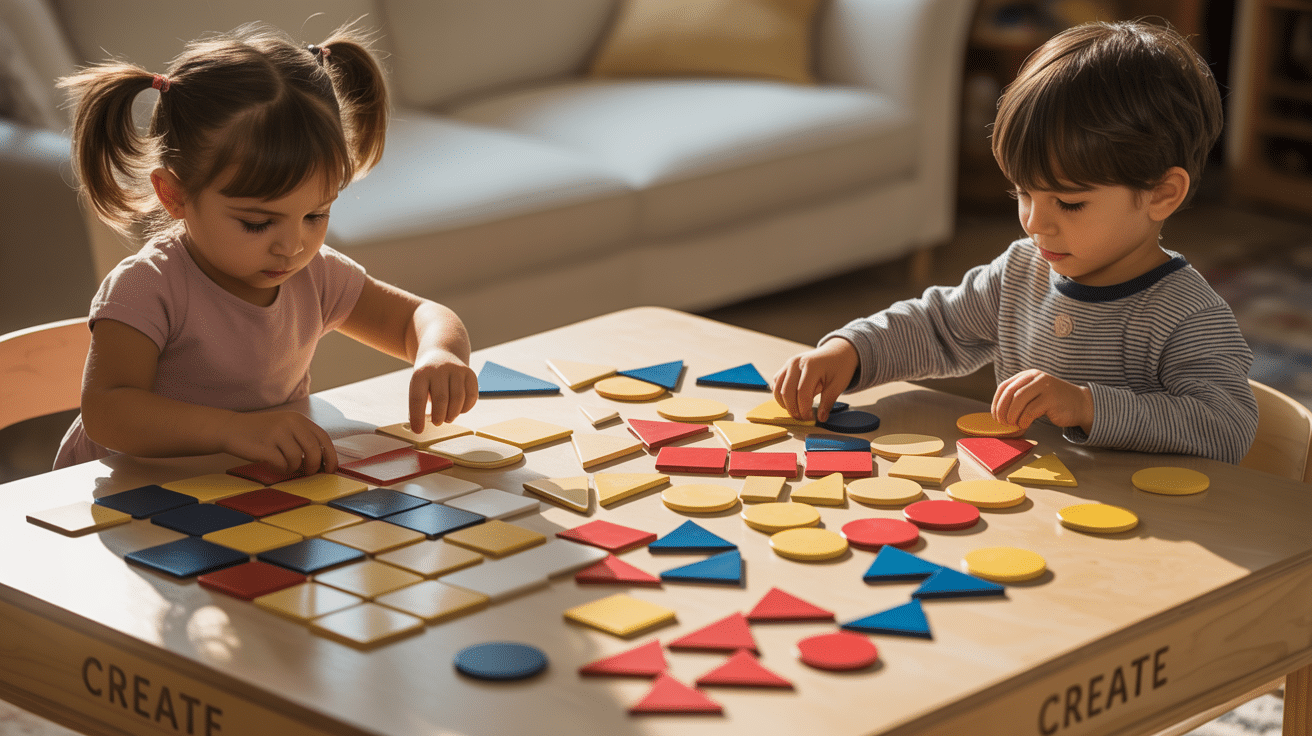
Pattern Blocks involve using different geometric shapes to create patterns. Children use the blocks to create visual patterns, which helps build their understanding of symmetry and shapes.
- Material Required: Pattern blocks, paper for designs.
- Lessons Covered: Pattern recognition, geometry, symmetry.
- Difficulty Level: Medium
6. Colorful Counting Cups
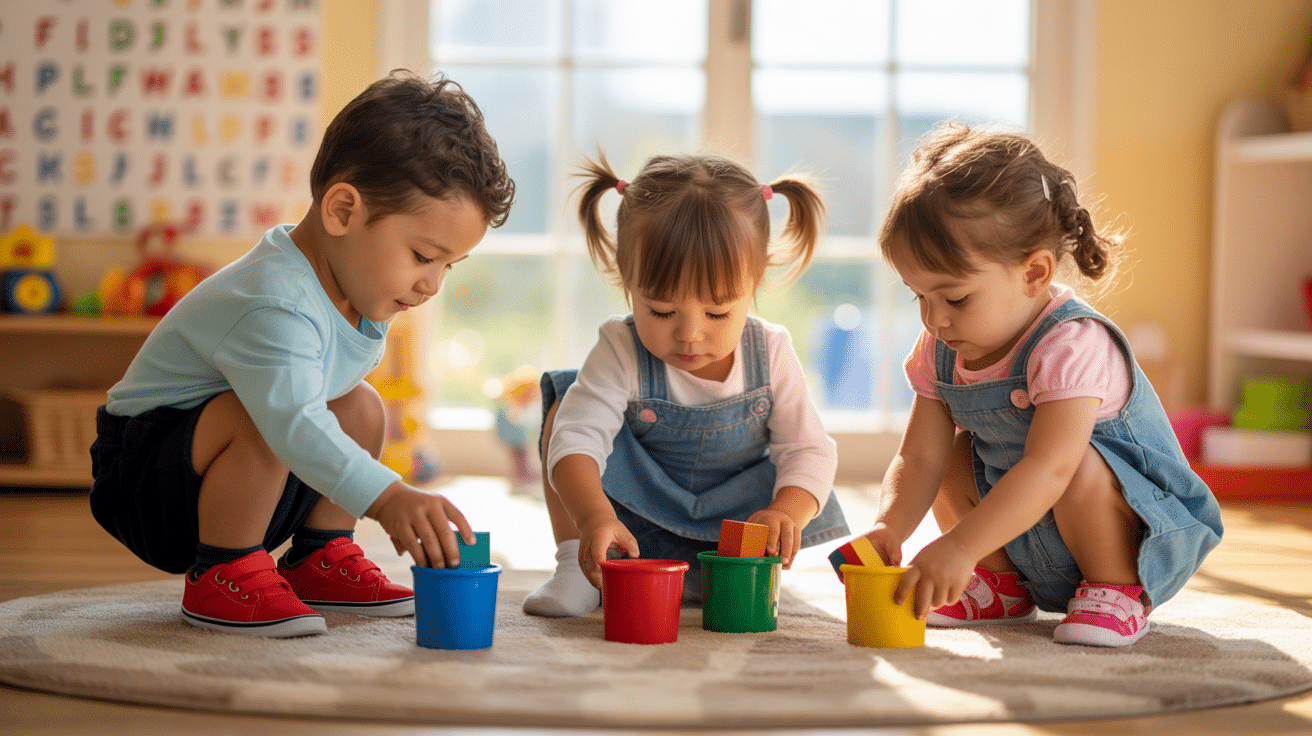
Colorful Counting Cups is a fun activity where preschoolers count items like beads or small toys that are placed inside colorful cups, helping them practice counting and recognizing colors.
- Material Required: Colorful cups, small objects such as beads or buttons.
- Lessons Covered: Counting, color recognition, fine motor skills.
- Difficulty Level: Easy
7. Shape Tracing
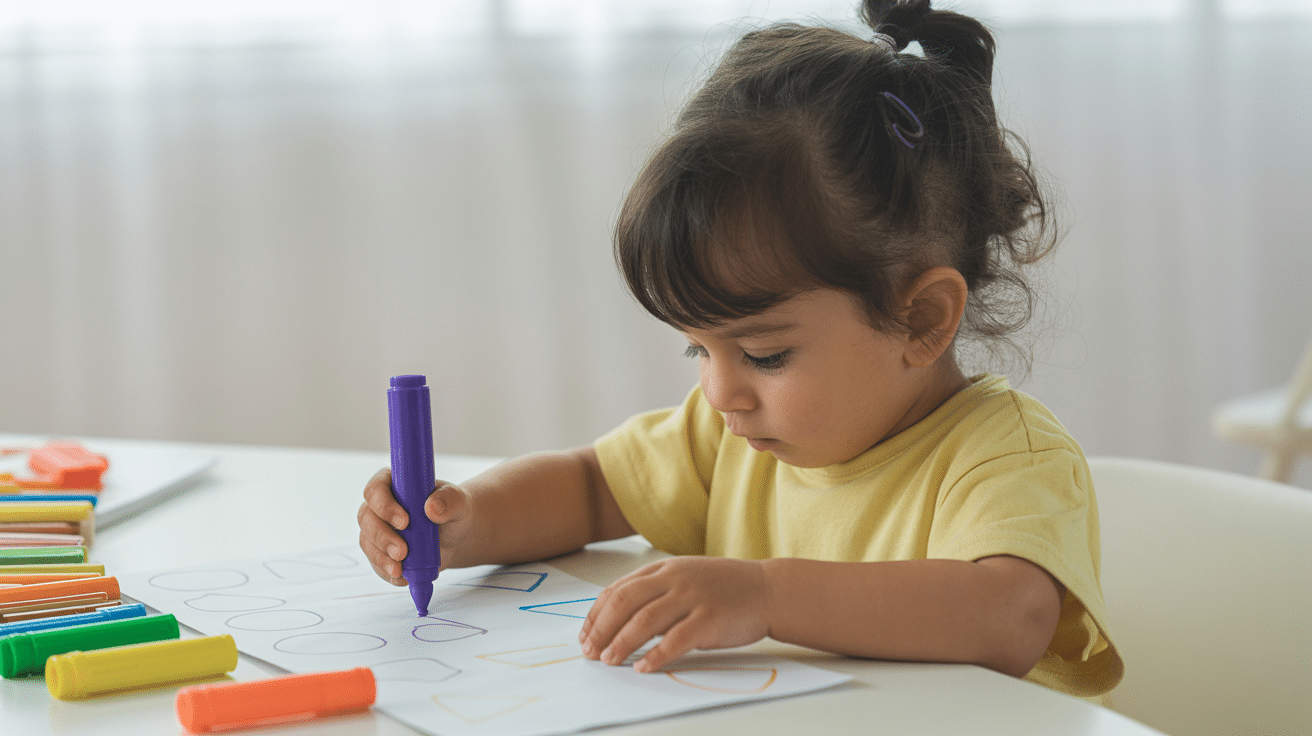
Shape Tracing allows children to trace various shapes on paper. It helps them develop their hand-eye coordination, shape recognition, and fine motor skills.
- Material Required: Shape stencils, paper, markers/crayons.
- Lessons Covered: Shape recognition, fine motor skills, hand-eye coordination.
- Difficulty Level: Easy
8. Number Line Jumping
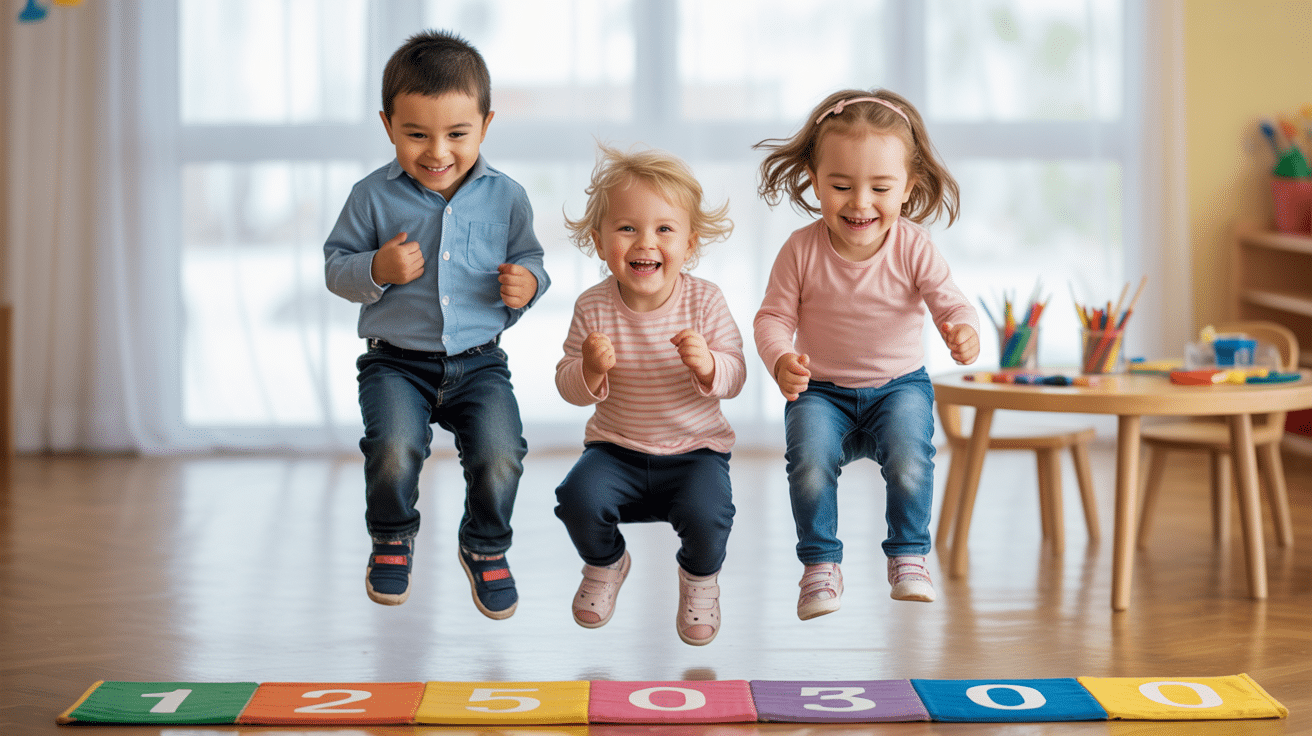
Number Line Jumping involves children jumping to different numbers on the floor, helping them practice counting, number recognition, and improving gross motor skills.
- Material Required: Number line (taped on the floor), space for jumping.
- Lessons Covered: Number recognition, counting, gross motor skills.
- Difficulty Level: Easy
9. Sorting by Size
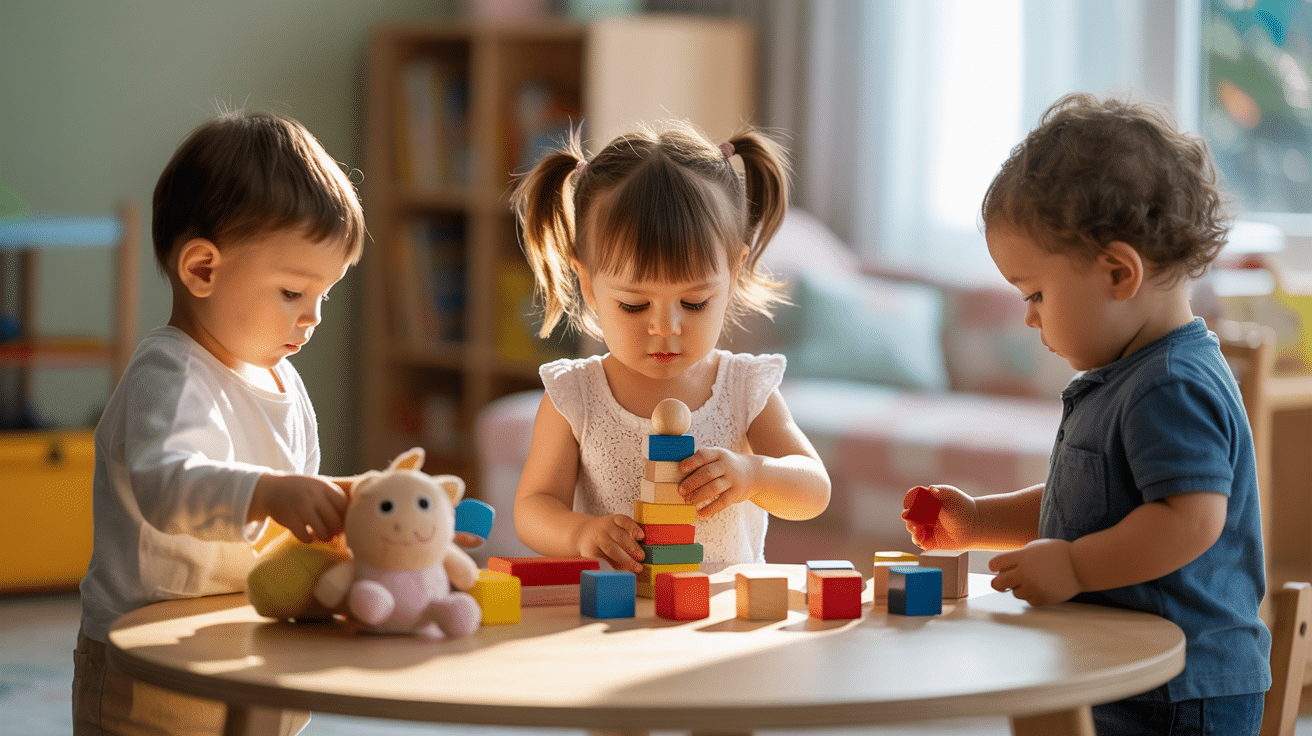
Sorting by Size helps preschoolers practice comparing and sorting objects by size. This strengthens their understanding of concepts like big, medium, and small.
- Material Required: Objects of varying sizes (blocks, toys, etc.).
- Lessons Covered: Size comparison, sorting, logical thinking.
- Difficulty Level: Easy
10. Counting and Clapping

In Counting and Clapping, children count a set of objects and clap the correct number of times. It is a great way to practice counting while incorporating rhythm and coordination.
- Material Required: Small objects to count, clapping hands.
- Lessons Covered: Counting, number recognition, rhythm, and coordination.
- Difficulty Level: Easy
11. Counting with Dice
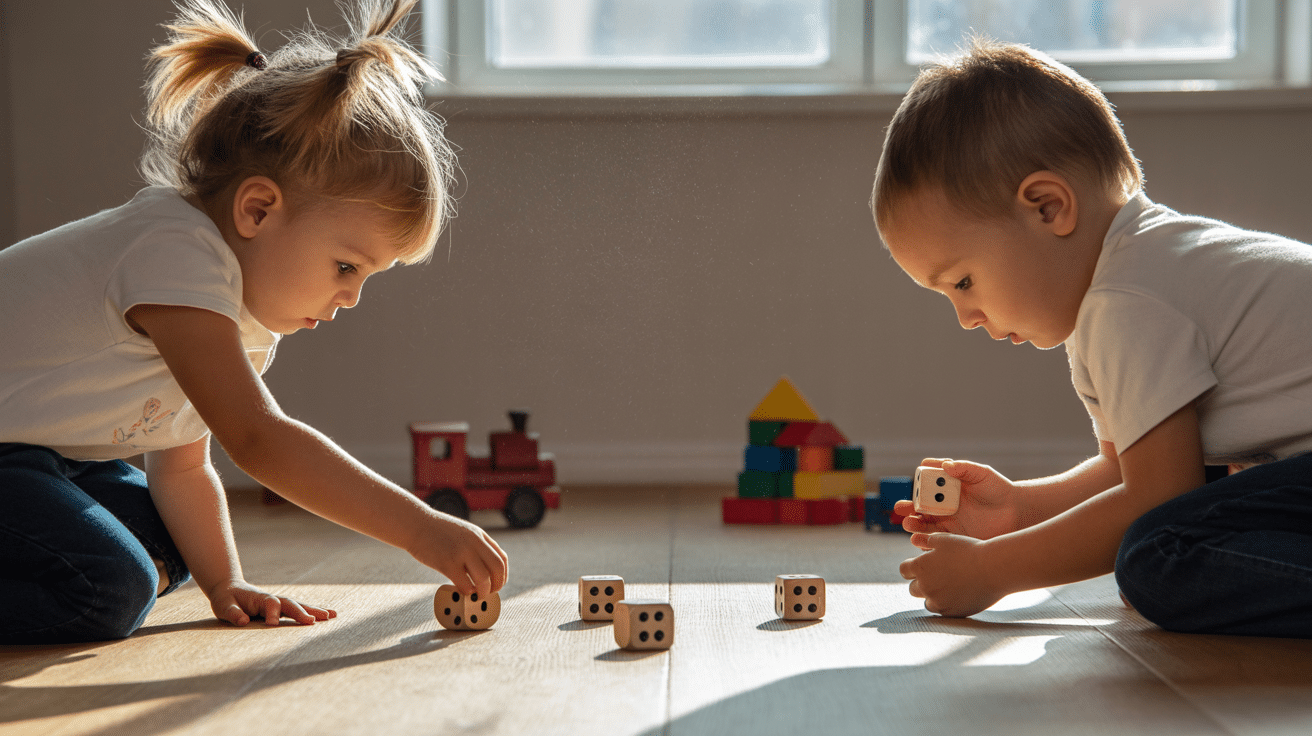
Counting with Dice involves rolling dice and counting the dots to practice number recognition and counting skills. This is a great way to build excitement around numbers.
- Material Required: Dice, small counters or toys.
- Lessons Covered: Counting, number recognition, probability.
- Difficulty Level: Easy
12. Sorting with Buttons
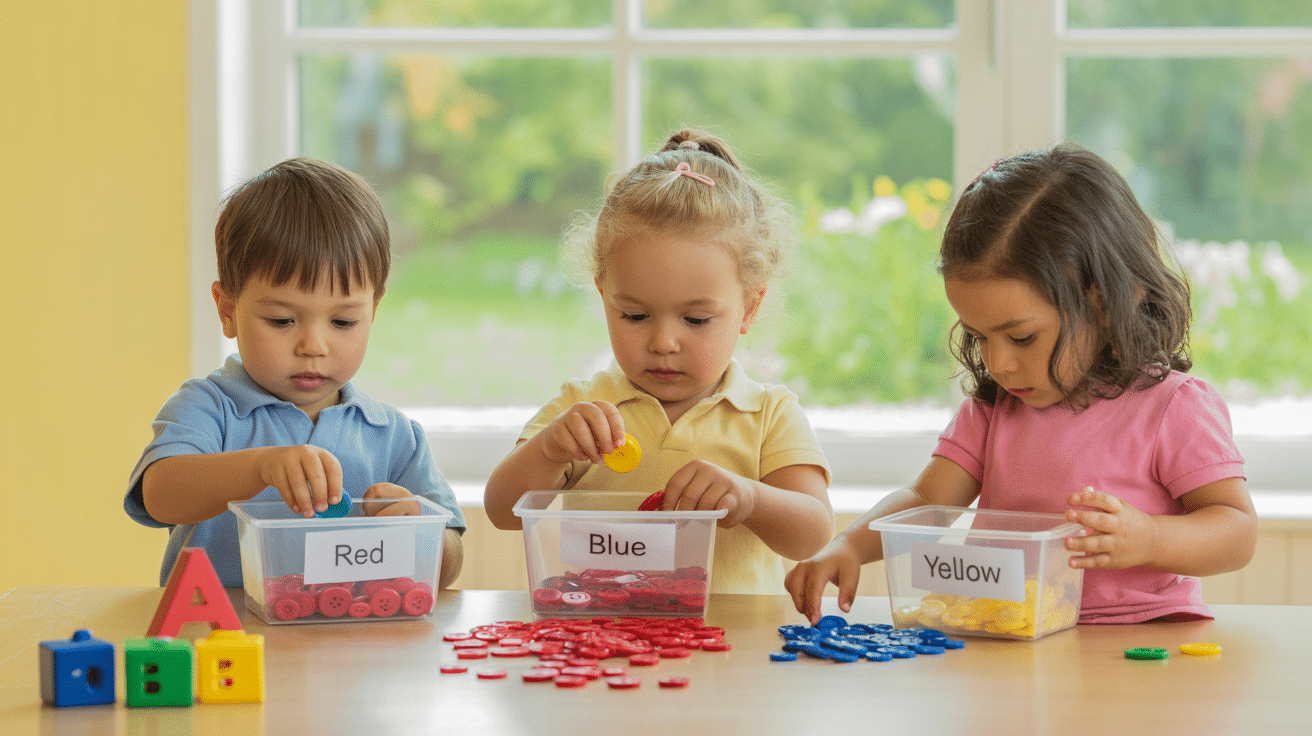
Sorting with Buttons involves sorting various buttons by color, size, or shape. This activity improves sorting skills and fine motor coordination.
- Material Required: Buttons in various shapes and sizes, containers for sorting.
- Lessons Covered: Sorting, color/size recognition, fine motor skills.
- Difficulty Level: Easy
13. Number Matching
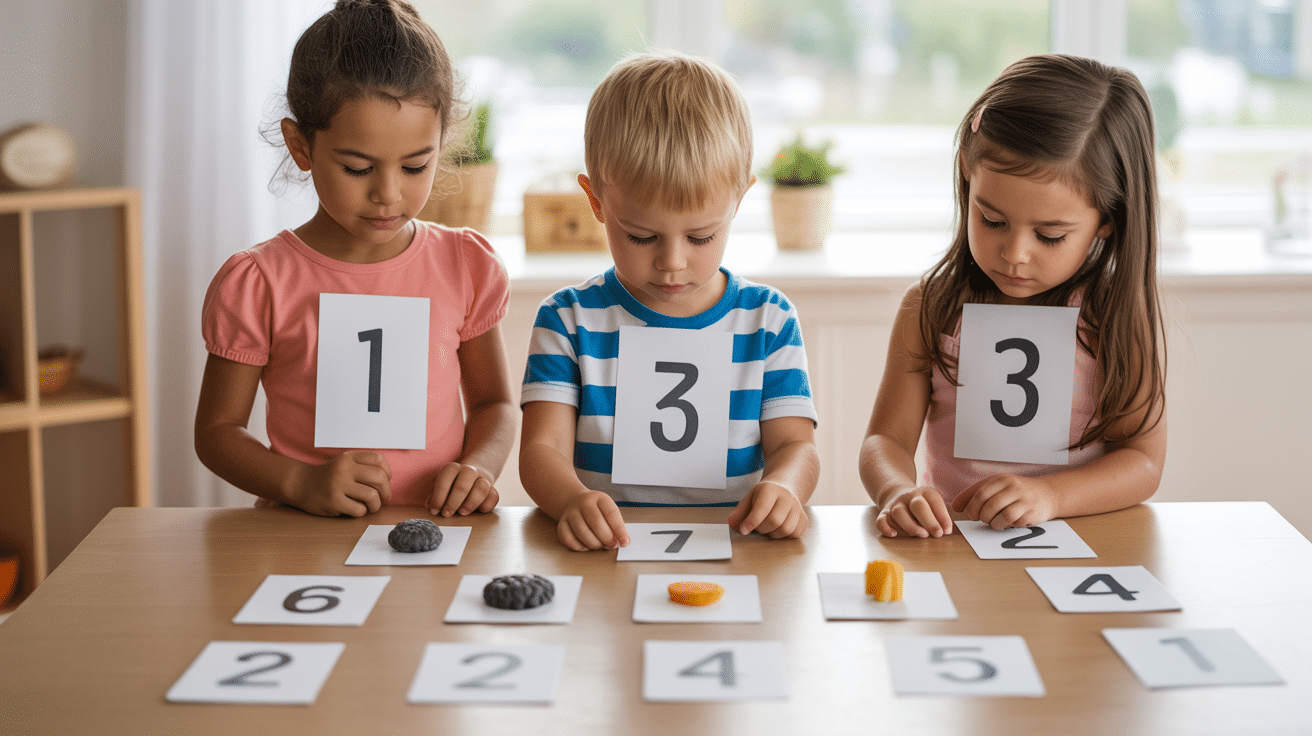
In Number Matching, children match number cards to corresponding groups of objects. This helps reinforce number recognition and counting skills.
- Material Required: Number cards, objects, or pictures to match.
- Lessons Covered: Number recognition, counting, matching.
- Difficulty Level: Easy
14. Shape Bingo
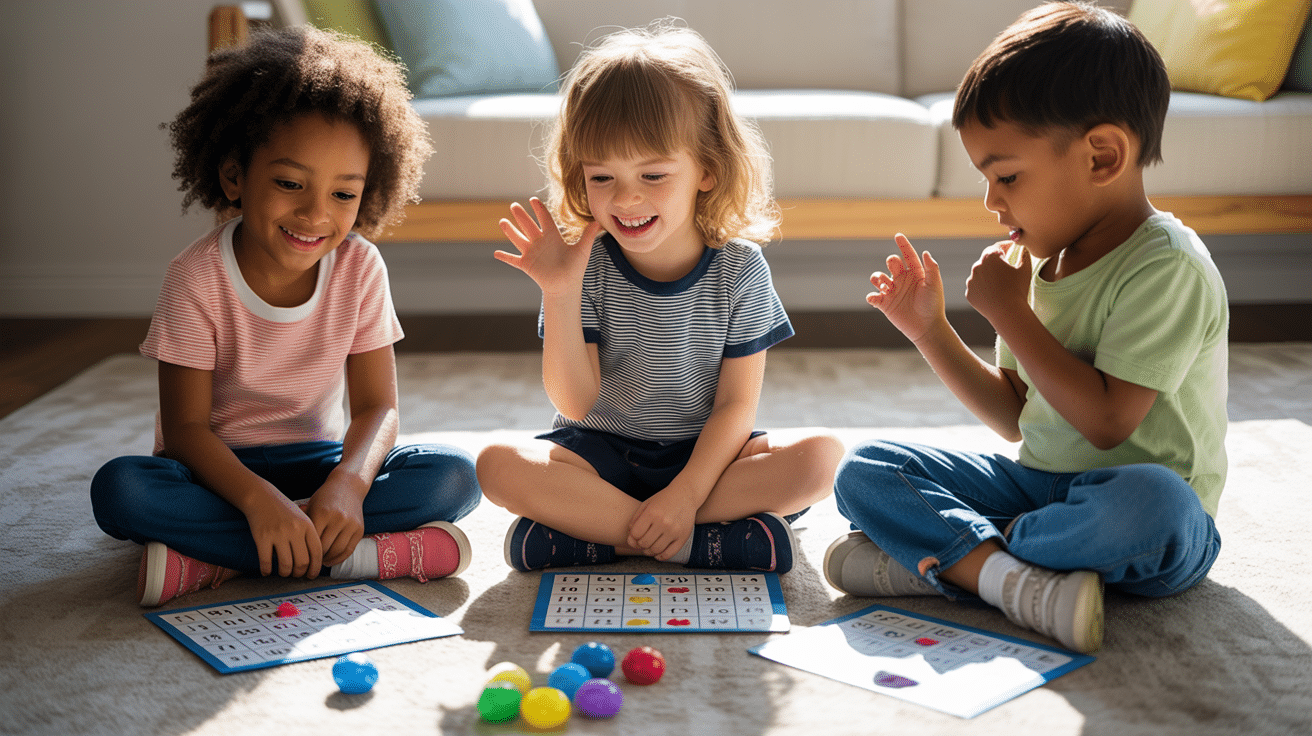
Shape Bingo is a fun game where children match shapes on their bingo cards. It reinforces shape recognition and can be played in a group for social interaction.
- Material Required: Bingo cards with shapes, markers, or tokens.
- Lessons Covered: Shape recognition, matching, and social skills.
- Difficulty Level: Easy
15. Counting with Snacks
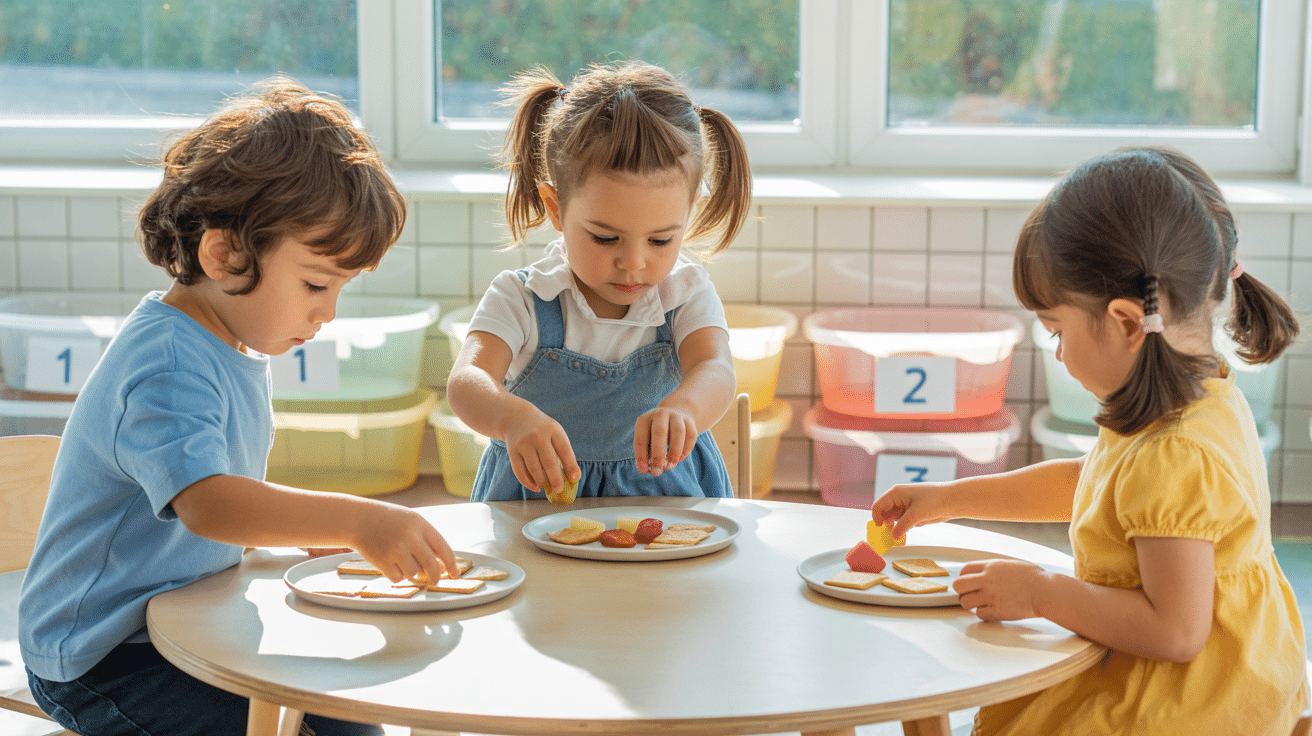
Counting with Snacks involves using snacks (like crackers or fruit pieces) to count and practice number recognition while also providing a treat for the kids.
- Material Required: Snacks (crackers, fruit, etc.), plates.
- Lessons Covered: Counting, number recognition, fine motor skills.
- Difficulty Level: Easy
16. Shape Collage
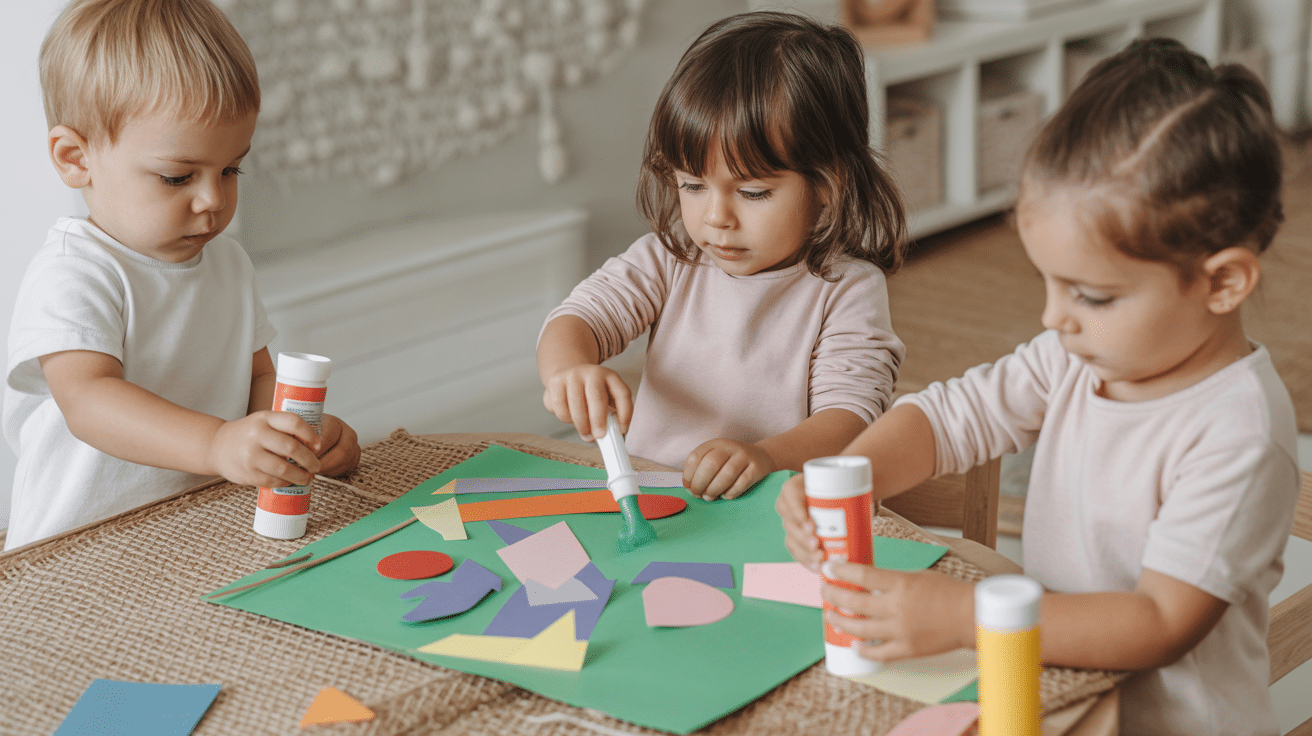
Shape Collage involves cutting out various shapes and gluing them onto paper to create a picture. This helps children explore shapes and creativity.
- Material Required: Paper, scissors, glue, and various colored shapes.
- Lessons Covered: Shape recognition, creativity, fine motor skills.
- Difficulty Level: Medium
17. Counting with Pegs
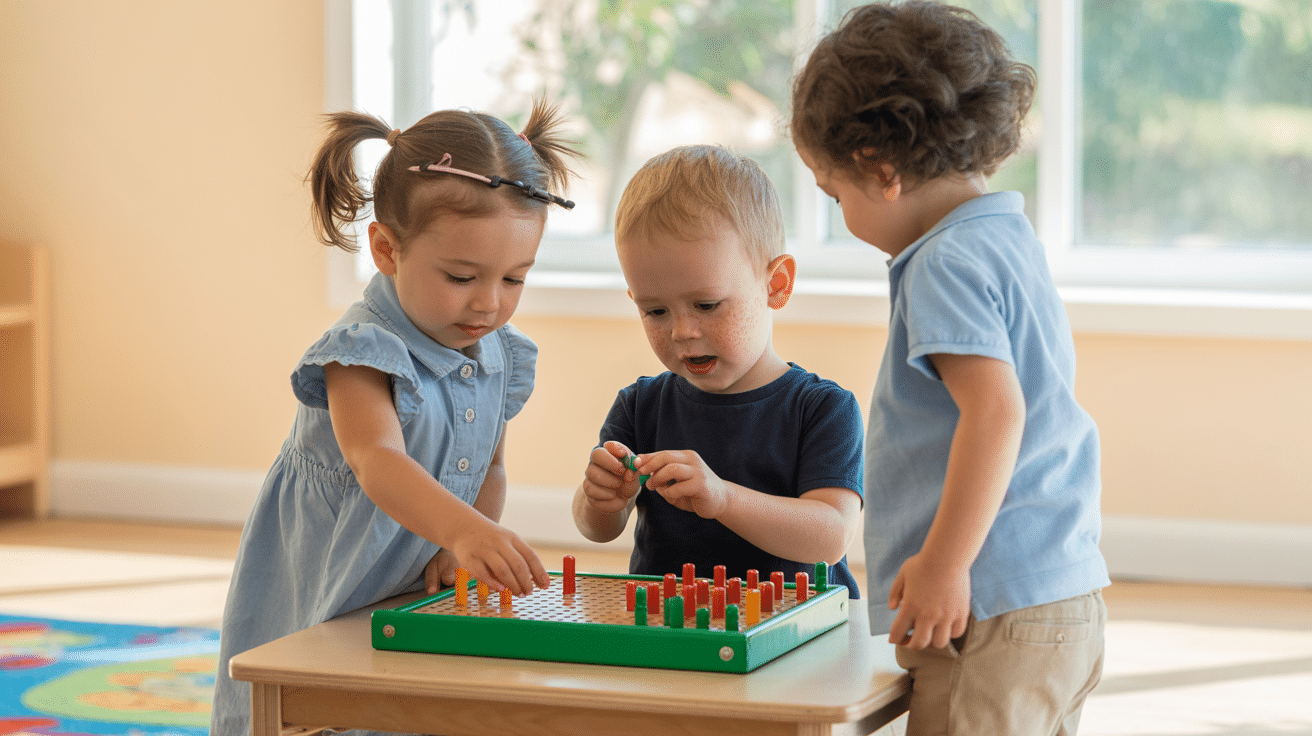
Counting with Pegs is an activity where children count pegs and place them into corresponding holes on a pegboard. This activity helps with number recognition and fine motor skills.
- Material Required: Pegboard, pegs, small containers.
- Lessons Covered: Counting, number recognition, fine motor skills.
- Difficulty Level: Medium
18. Number Puzzle Games
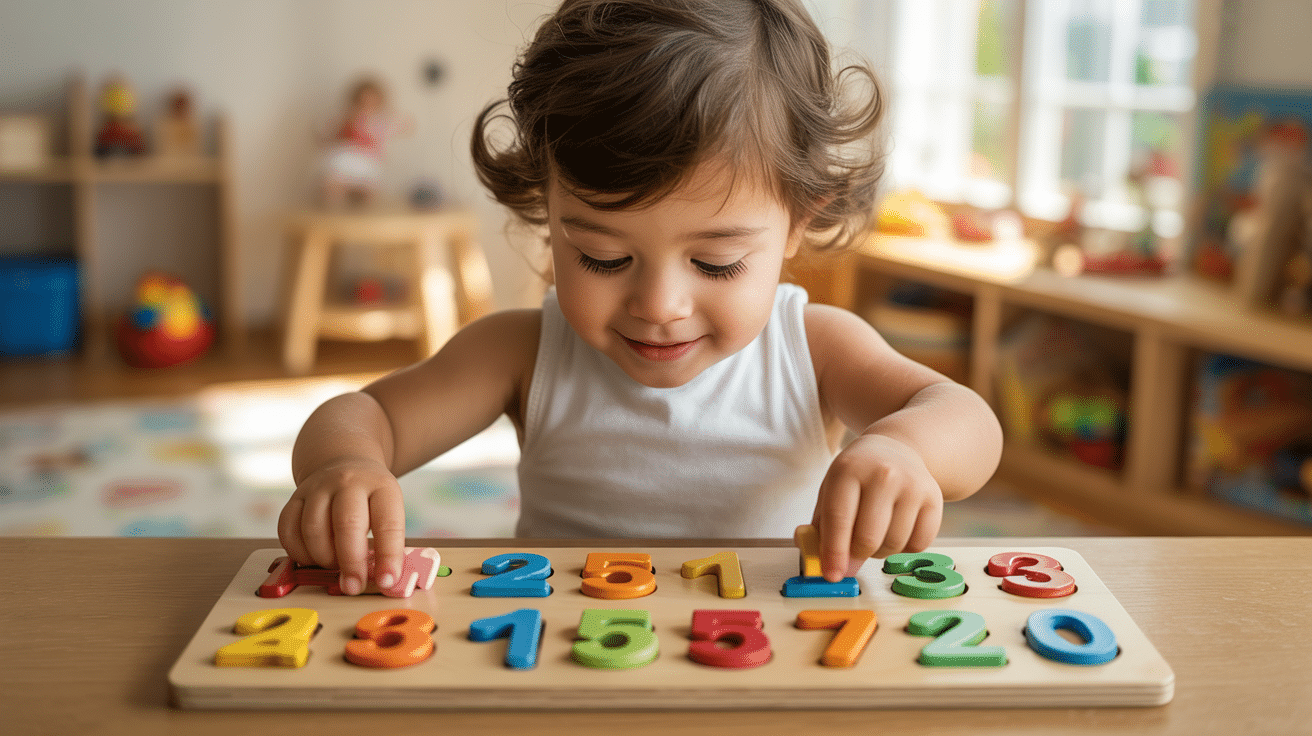
Number Puzzle Games involve fitting number pieces into puzzles to complete them, reinforcing number recognition and problem-solving skills.
- Material Required: Number puzzle pieces, puzzle board.
- Lessons Covered: Number recognition, problem-solving, fine motor skills.
- Difficulty Level: Medium
19. Sorting by Color
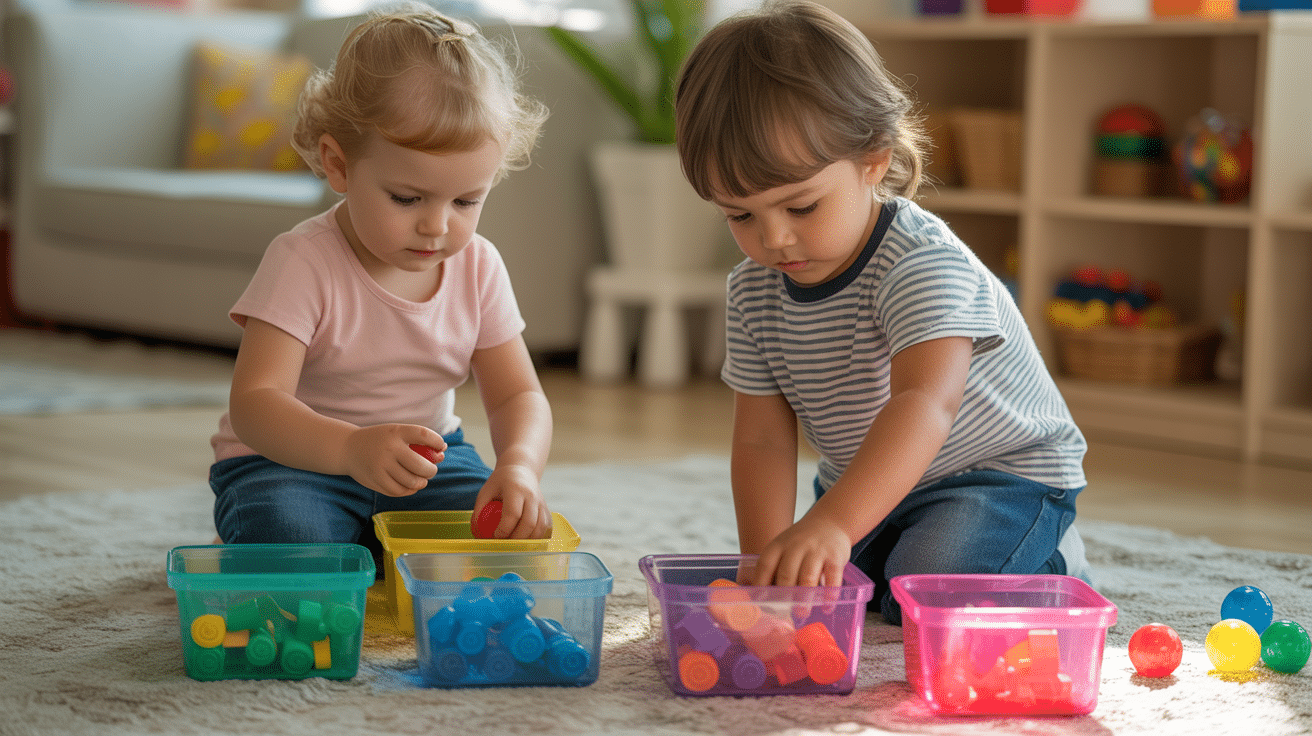
Sorting by Color involves sorting various objects based on their colors. This helps children develop color recognition and sorting skills.
- Material Required: Colorful objects (blocks, balls, etc.), sorting containers.
- Lessons Covered: Color recognition, sorting, logical thinking.
- Difficulty Level: Easy
20. Counting with Cars
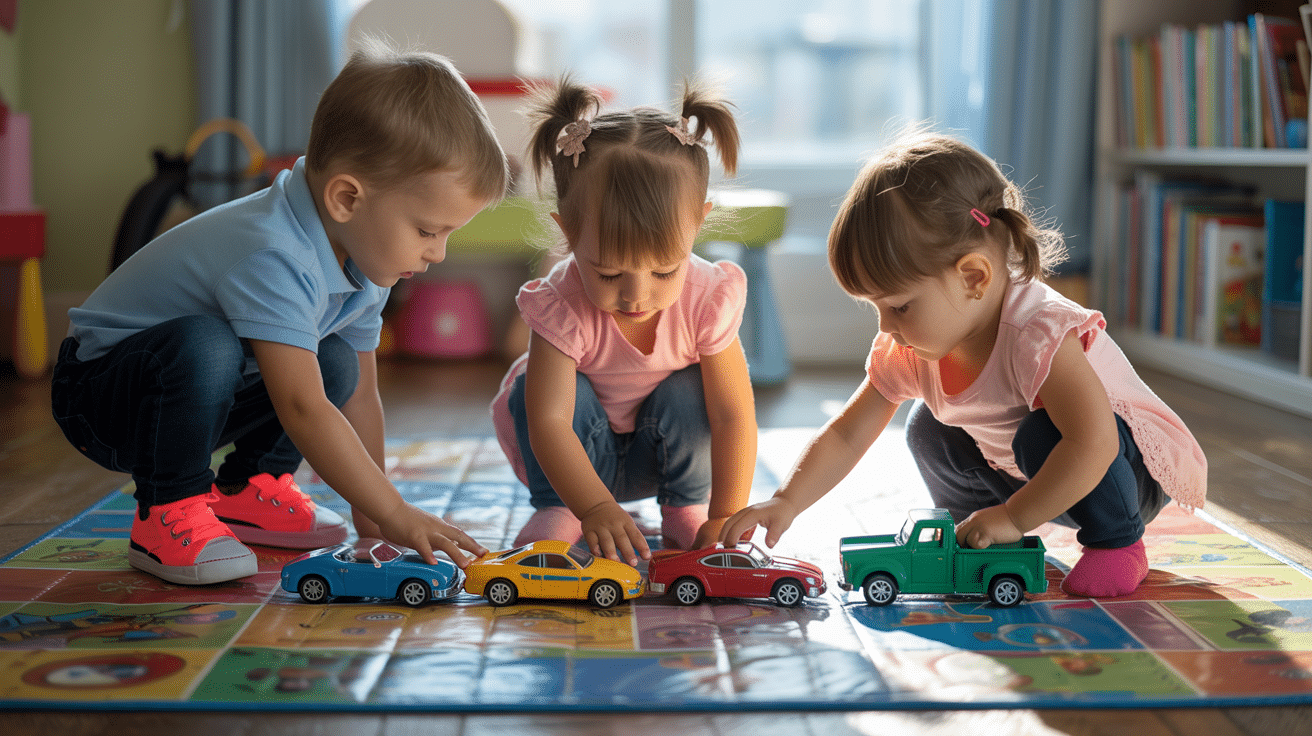
Counting with Cars lets children count toy cars or vehicles while organizing them in various ways. This makes counting more engaging for young learners.
- Material Required: Toy cars, a play mat or surface.
- Lessons Covered: Counting, number recognition, sorting.
- Difficulty Level: Easy
21. Shape and Color Hunt
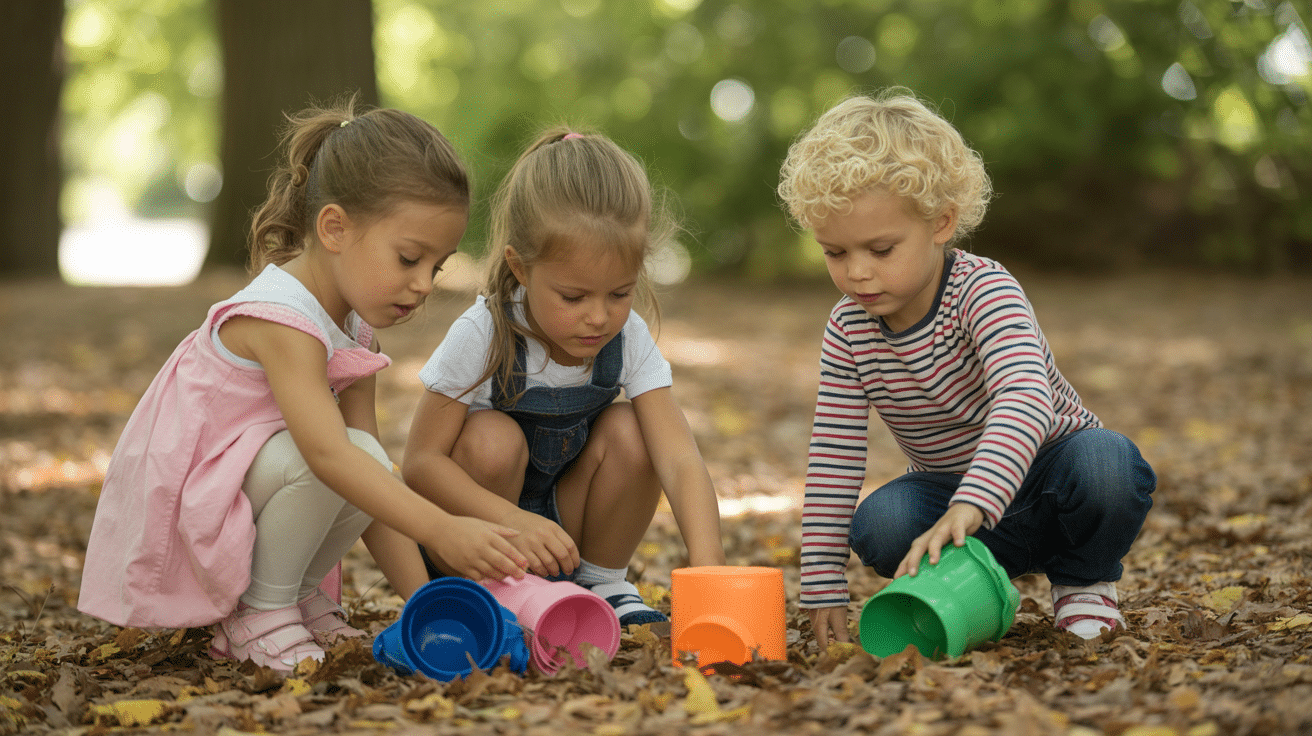
The Shape and Color Hunt involves finding objects in the environment that match specific shapes or colors, encouraging active exploration and recognition.
- Material Required: List of shapes/colors, a space to explore.
- Lessons Covered: Shape/color recognition, observation, and exploration.
- Difficulty Level: Easy
Other Creative Math Activities for for Preschoolers
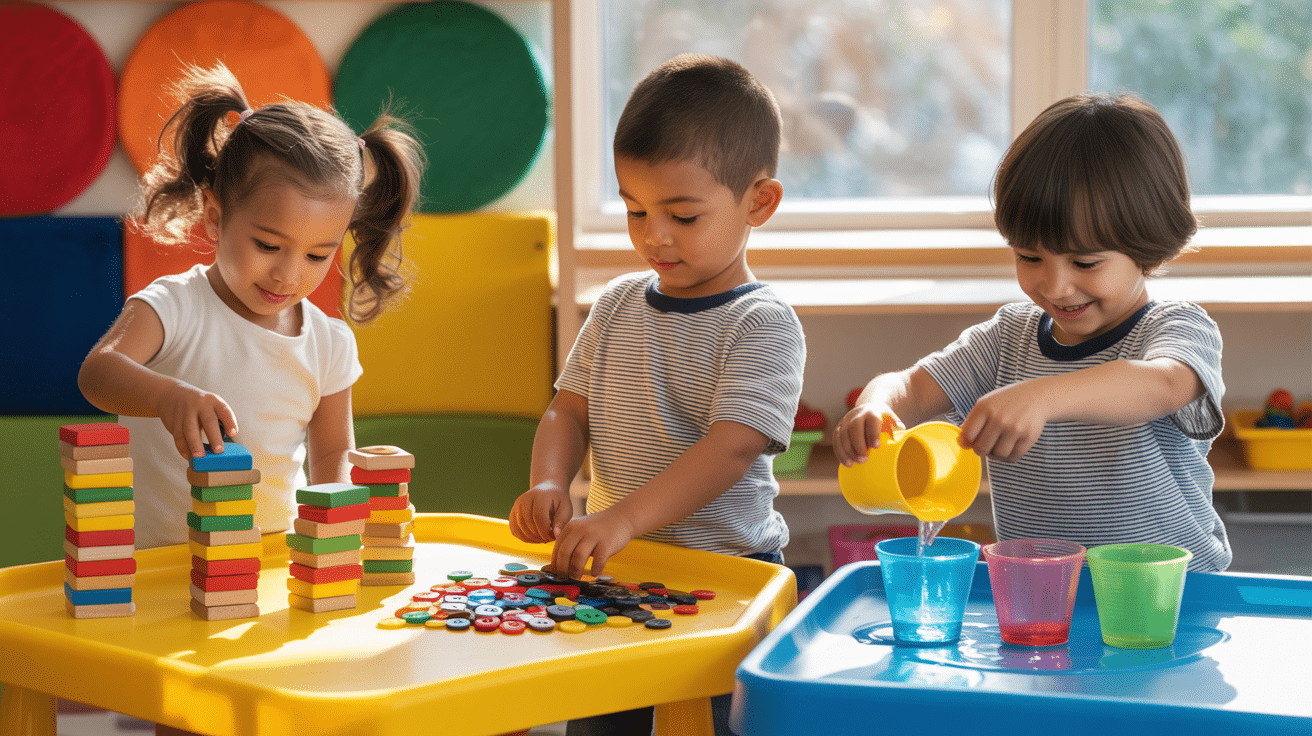
Let’s see some more fun math activities that preschoolers should play to build strong problem-solving and cognitive skills. These involve:
22. Building Towers by Size: It teaches children to stack blocks by size, helping them understand size comparison and spatial relationships.
23. Counting on Fingers: It involves children using their fingers to count, which helps reinforce number recognition and counting.
24.Shape Drawing: It involves children drawing various shapes, enhancing their creativity while reinforcing shape recognition.
25. Stacking Cups by Number: It teaches children to organize and stack cups in numerical order, fostering number recognition and fine motor skills.
26. Measuring with Blocks: Measuring with Blocks helps children understand the concept of measurement by comparing block lengths.
27.Counting with Beads: It is a hands-on activity where children use beads to count, which helps reinforce counting and pattern recognition.
28.Shape Construction with Straws: It allows children to create shapes by connecting straws, promoting shape recognition and spatial skills.
29.Counting Stamps: It uses stamps to teach children to count and match numbers to corresponding amounts.
30.Number Matching Cards: It is a simple game where children match number cards with the correct number of objects.
31.Shape & Number Sticker Fun: This fun activity uses stickers to match shapes and numbers to corresponding objects on a worksheet.
32.Sorting by Texture: It helps children classify objects into groups based on their shape, enhancing their categorization and sorting abilities.
33.Counting with Sticks: It involves placing stickers on paper and counting them, which is a fun way to practice number recognition.
34.Puzzle Piece Matching: Children match puzzle pieces to reinforce pattern recognition and cognitive development.
35.Number Tracing: Kids trace numbers with a pencil or crayon to improve number recognition and fine motor skills.
36.Count and Paint: Children count the items they paint, combining creativity with counting practice.
37.Shape Hunt with Flashlights: Children use flashlights to find and identify shapes around the room or outdoor space.
38.Counting with Toy Animals: Preschoolers count toy animals to practice number recognition and counting in a playful way.
39. Pattern Recognition with Toys: Children use toys to create and recognize patterns, improving their logical thinking skills.
40.Playdough Shape Making: Kids use playdough to form various shapes, encouraging creativity and shape recognition.
41.Number Recognition with Flashcards: Flashcards are used to help children recognize and identify numbers, enhancing their number skills.
42.Building Numbers with Blocks: Children use blocks to construct numbers, helping them visualize and practice number formation.
43.Sorting Objects by Shape: Preschoolers sort objects based on shape, strengthening categorization and shape recognition skills.
44.Counting by Twos with Toys: Children practice counting by twos using toys, reinforcing skip counting and number patterns.
45.Shape Paper Folding: Kids fold paper into various shapes, helping them understand geometry and shape manipulation.
46.Counting with Stickers: Children place and count stickers, providing a fun and interactive way to practice counting.
47.Measuring with Toy Cars: Using toy cars to measure distances or lengths helps children understand basic measurement concepts.
48.Counting with Finger Puppets: Finger puppets are used to count objects, creating an engaging and interactive learning experience.
49.Number Identification Game: Children play a game to identify numbers, enhancing their recognition skills through active play.
50.Shape Flashcards: Shape flashcards are used to teach children about different shapes, improving their shape recognition abilities.
51.Sorting with Crayons: Kids sort crayons by color, promoting color recognition and sorting skills.
52.Watermelon Seed Counting: Children count watermelon seeds or similar small items, reinforcing counting and number recognition.
53.Shape Walk: Preschoolers go on a walk to find shapes in the environment, reinforcing shape recognition and observation.
54.Number Collage Craft: Children create a collage by gluing items to form numbers, improving their creativity and number recognition.
55.Counting with Fruit Slices: Children count fruit slices, combining real-world objects with counting practice for hands-on learning.
56.Estimation Games: Kids estimate the number of objects and then count them, practicing both estimation and counting skills.
57.Counting with Buttons: Children use buttons to practice counting and number recognition, adding a tactile element to learning.
58.Color by Number: Kids color pictures according to numbered sections, enhancing number recognition and following instructions.
59.Shape Sorting with Legos: Children sort Lego pieces by shape, reinforcing shape recognition and categorization skills.
60.Counting with Jenga Blocks:
Using Jenga blocks, children count and build, developing counting skills through interactive play.
61.Count the Steps: Children count each step while walking, reinforcing number sequencing and gross motor skills.
How to Involve Preschoolers in Fun Math Activities
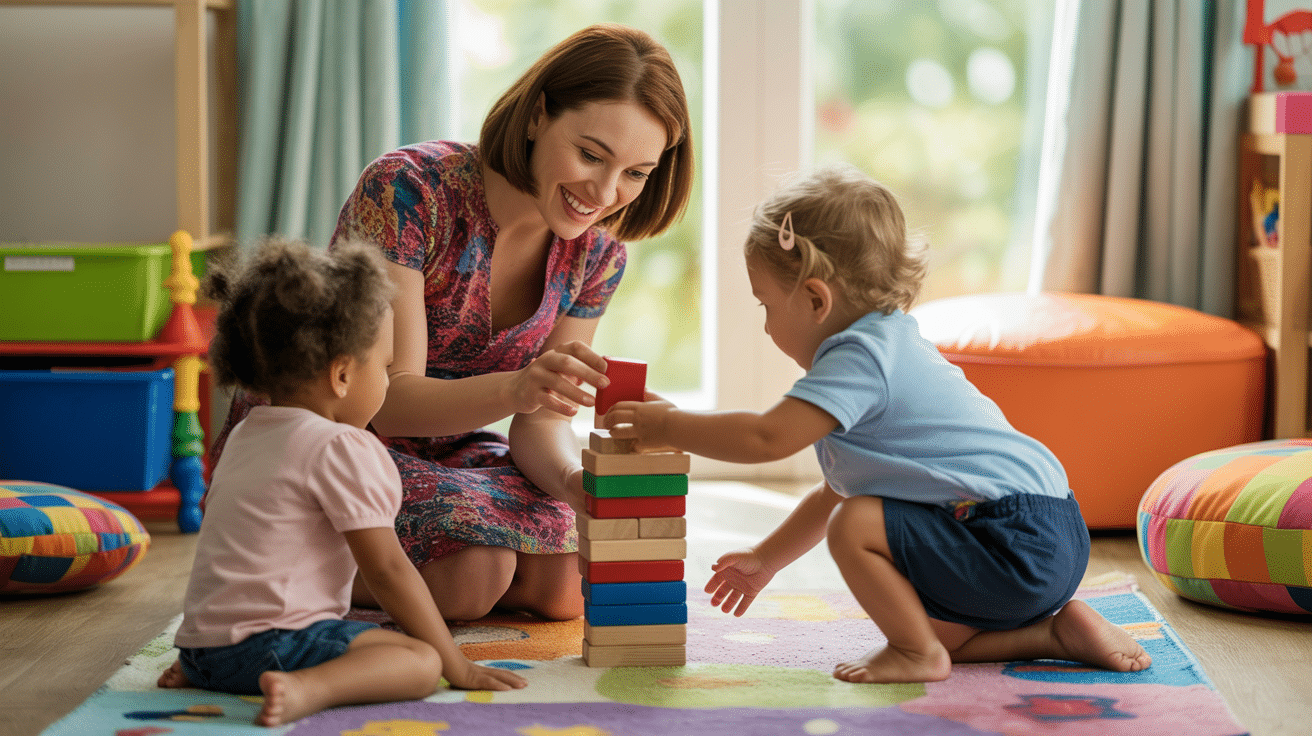
Getting preschoolers excited about math starts with understanding how their minds work.
Young children learn best through play, movement, and hands-on experiences. They need to touch, see, and move materials around to grasp new concepts.
Hide Math in Everyday Play:
Use regular toys and household items to teach numbers without kids knowing it. When they stack blocks or sort crayons, they’re actually doing math. The key is choosing activities that feel like natural playtime.
Keep Math Sessions Short:
Plan 10-15 minute activities throughout the day. Short bursts work better than long lessons. This keeps kids interested and prevents them from getting tired or frustrated.
Use Real-Life Math Moments:
Count stairs while walking up. Sort toys by color. Compare who has more crackers at snack time. Daily activities become perfect math lessons that kids actually understand.
Praise Every Small Step:
Celebrate when kids try, even if they make mistakes. If they count “one, two, four, five,” praise them for remembering most numbers. This builds confidence and makes them want to keep learning.
Add Movement and Songs:
Get kids moving while they learn. Jump while counting. Clap to number songs. Dance in patterns. Moving helps kids remember better and makes math more fun.
Conclusion
As a parent or teacher, you know how hard it can be to make math fun for little ones. This list of 61 math activities for preschoolers gives you precisely what you need. Simple games that work with the Material you already have at home.
Your child will love these activities because they feel like play, not lessons.
These preschool math activities fit into your daily routine easily. Count while folding clothes. Sort during snack time. Play number games in the car. Math becomes part of everyday life without extra stress.
These activities build your child’s confidence with numbers. They also them for school success.
Pick one activity today. Watch your preschooler smile while learning math.


